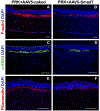Gene Therapy in the Anterior Eye Segment
- PMID: 33902406
- PMCID: PMC8531184
- DOI: 10.2174/1566523221666210423084233
Gene Therapy in the Anterior Eye Segment
Abstract
This review provides comprehensive information about the advances in gene therapy in the anterior segment of the eye, including cornea, conjunctiva, lacrimal gland, and trabecular meshwork. We discuss gene delivery systems, including viral and non-viral vectors as well as gene editing techniques, mainly CRISPR-Cas9, and epigenetic treatments, including antisense and siRNA therapeutics. We also provide a detailed analysis of various anterior segment diseases where gene therapy has been tested with corresponding outcomes. Disease conditions include corneal and conjunctival fibrosis and scarring, corneal epithelial wound healing, corneal graft survival, corneal neovascularization, genetic corneal dystrophies, herpetic keratitis, glaucoma, dry eye disease, and other ocular surface diseases. Although most of the analyzed results on the use and validity of gene therapy at the ocular surface have been obtained in vitro or using animal models, we also discuss the available human studies. Gene therapy approaches are currently considered very promising as emerging future treatments of various diseases, and this field is rapidly expanding.
Keywords: CRISPR-Cas9; Gene therapy; adeno-associated virus; adenovirus; antisense; cornea; corneal dystrophy; corneal neovascularization; corneal wound healing; drug delivery; dry eye; glaucoma; graft survival; keratitis; lentivirus; nanoconstruct; non-viral vector; retrovirus; siRNA.
Copyright© Bentham Science Publishers; For any queries, please email at epub@benthamscience.net.
Conflict of interest statement
CONFLICT OF INTEREST
AVL is an officer and stockholder of Arrogene Nanotechnology, Inc., 8560 West Sunset Boulevard, Suite 424, Los Angeles, CA 90069, USA.
Figures







Similar articles
-
Limbal stem cell transplantation: an evidence-based analysis.Ont Health Technol Assess Ser. 2008;8(7):1-58. Epub 2008 Oct 1. Ont Health Technol Assess Ser. 2008. PMID: 23074512 Free PMC article.
-
Targeting corneal inflammation by gene therapy: Emerging strategies for keratitis.Exp Eye Res. 2018 Nov;176:130-140. doi: 10.1016/j.exer.2018.07.006. Epub 2018 Jul 4. Exp Eye Res. 2018. PMID: 29981344 Review.
-
Personalised genome editing - The future for corneal dystrophies.Prog Retin Eye Res. 2018 Jul;65:147-165. doi: 10.1016/j.preteyeres.2018.01.004. Epub 2018 Jan 31. Prog Retin Eye Res. 2018. PMID: 29378321 Review.
-
Corneal gene therapy.J Control Release. 2007 Dec 20;124(3):107-33. doi: 10.1016/j.jconrel.2007.05.041. Epub 2007 Jul 4. J Control Release. 2007. PMID: 17707107 Review.
-
New Frontier in the Management of Corneal Dystrophies: Basics, Development, and Challenges in Corneal Gene Therapy and Gene Editing.Asia Pac J Ophthalmol (Phila). 2022 Jul-Aug 01;11(4):346-359. doi: 10.1097/APO.0000000000000443. Epub 2022 Aug 30. Asia Pac J Ophthalmol (Phila). 2022. PMID: 36041149 Review.
Cited by
-
Herpes simplex keratitis: A brief clinical overview.World J Virol. 2024 Mar 25;13(1):89934. doi: 10.5501/wjv.v13.i1.89934. World J Virol. 2024. PMID: 38616855 Free PMC article. Review.
-
Elevated Intraocular Pressure and Glaucomatous Optic Neuropathy: Genes to Disease Mechanisms, Therapeutic Drugs, and Gene Therapies.Pharmaceuticals (Basel). 2023 Jun 12;16(6):870. doi: 10.3390/ph16060870. Pharmaceuticals (Basel). 2023. PMID: 37375817 Free PMC article. Review.
-
Corneal gene therapy: Structural and mechanistic understanding.Ocul Surf. 2023 Jul;29:279-297. doi: 10.1016/j.jtos.2023.05.007. Epub 2023 May 25. Ocul Surf. 2023. PMID: 37244594 Free PMC article.
-
Revisiting Retinal Degeneration Hallmarks: Insights from Molecular Markers and Therapy Perspectives.Int J Mol Sci. 2023 Aug 23;24(17):13079. doi: 10.3390/ijms241713079. Int J Mol Sci. 2023. PMID: 37685886 Free PMC article. Review.
-
CRISPR-Cas9-mediated deletion of carbonic anhydrase 2 in the ciliary body to treat glaucoma.Cell Rep Med. 2024 May 21;5(5):101524. doi: 10.1016/j.xcrm.2024.101524. Epub 2024 Apr 25. Cell Rep Med. 2024. PMID: 38670096 Free PMC article.
References
Publication types
MeSH terms
Grants and funding
LinkOut - more resources
Full Text Sources
Other Literature Sources

